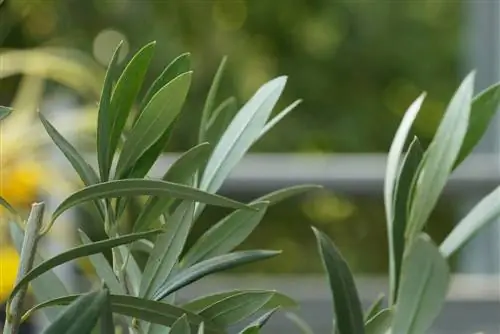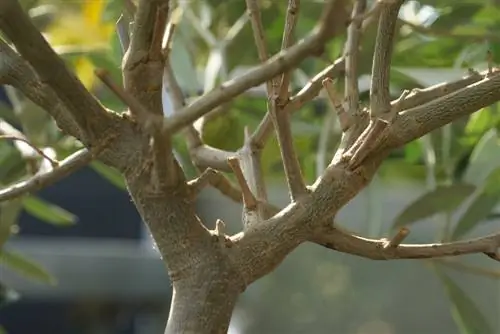- Author admin [email protected].
- Public 2023-12-17 03:39.
- Last modified 2025-01-24 12:45.
If an olive tree gives the gardener a headache, it is usually due to leaf loss. The leaves turn yellow and fall off, especially in winter. This reaction results from various causes that unbalance the Mediterranean tree, causing it to resort to this drastic survival strategy. Consequently, such damage should be perceived as an alarm signal that requires immediate action. The following analysis highlights common causes of yellow leaves and provides helpful instructions for solving the problem.
Lack of light
Solution: Relocate or illuminate with plant lamps
In their natural distribution areas along the Mediterranean, olive trees can enjoy the sun for 12 hours or longer. The plants have adapted to this with their growth. This requirement remains unchanged for Olea europaea from local tree nurseries. North of the Alps, the reduced hours of sunshine are a frequent problem for Mediterranean ornamental and fruit trees. As long as they are on the summer south-facing balcony, the evergreen leaves stay in their place. At the latest in the low-light winter quarters, the leaves turn yellow and fall off. The higher the temperatures in the room, the more drastic the leaf fall occurs. How to fix the problem:
- Replace the pot in a sunny location with temperatures between 5 and 10 degrees Celsius
- Under the influence of temperatures of more than 10 degrees, compensate for the increased light requirement with plant lamps
- Light the olive tree for at least 8 to 10 hours every day
Conventional lamps are not ideal for the desired effect. Therefore, choose special lights with a red-blue light spectrum and an output of 14 to 15 watts. A lampshade with a reflector coating ensures optimal light output. If there is uncertainty as to whether the amount of light is sufficient to stop leaf fall, investing in a light meter makes sense. This device determines the amount of light per square meter in lux. For your olive tree, this value should be at least 2,000 lux if it is kept cool over the winter.
Tip:
Leafless olive branches do not automatically mean that the shoot has died. Before you reach for the scissors in spring, please carry out a vitality test. A piece of bark is scraped off the bare branch. If there is green tissue underneath, the young leaves will not be long in coming.
An excess of wetness
Solution: Repotting and watering in accordance with the species
In late winter and early spring, complaints about leaf fall on the olive tree increase in the Mediterranean garden. Excessive watering in the winter quarters will now be punished. Under certain circumstances, the temperatures have already allowed for wintering, but spring brings massive rainfall. While the flood of water on the planted real olive tree can seep into the permeable soil, it does not drain away or does not drain quickly enough in the bucket. At this time of year the sun is not yet intense enough for excess moisture to evaporate quickly. Under these conditions, yellow, falling leaves are inevitable. In two stages you can help your olive tree regain its evergreen leaves:
First stage: repotting
If the olive tree has not yet fully rooted the pot, you can use the container again. In this case, please check carefully whether there are sufficiently large openings in the floor for water drainage. A new pot should be a maximum of 4 to 6 cm larger in diameter. As a substrate, we recommend a loose mixture of 3 parts compost, 2 parts coconut or wood fibers and 1 part vital lime. Adding a few more handfuls of sand will optimize the permeability of the soil. How to repot correctly:
- Pull out the sodden root ball to completely remove the soil
- Cut off softened, rotten root strands
- Cover the bottom opening in the pot with drainage made of pottery shards, grit or expanded clay balls
- Cover the water-conducting layer with an air- and water-permeable fleece

First fill the pot with enough substrate so that the root disc is approximately 3 cm below the edge of the container. Place the root ball on top and fill the cavities with soil. First place the olive tree in a partially shaded location for a week where it can regenerate. Afterwards, choose a sunny and rain-protected place to prevent renewed waterlogging as a result of too much rain.
Second stage: Watering correctly using a moisture meter
If waterlogging has caused yellow leaves and leaf loss, in this special case the repotting campaign does not end in abundant watering. Since the crown is without leaves, there is hardly any evaporation. At least during the regeneration phase, the water requirements in the olive tree are still covered. Use this time to purchase a simple moisture meter. This device now makes the difficult decision of when and how much to water your olive tree easier. The probe is inserted into the substrate. The integrated scale shows whether the soil is wet, semi-dry or dried out. How to water in accordance with the species:
- If the moisture meter signals that the substrate is dry, it will be watered
- Let the normal tap water slowly run onto the root disk
- If the first drops run out from under the bucket, watering is stopped
In the summer, an olive tree is watered much more often than in the winter. If there is any doubt about whether to water or not, leave the watering can standing. A real olive tree can easily tolerate short-term drought without immediately losing its leaves.
Nutrient Deficiency
Solution: Fertilize with a focus on nitrogen
If you cultivate your olive tree planted in the garden, you can exclude this point in the cause analysis for yellow leaves and leaf fall. Since an Olea europaea roots itself up to 7 meters deep in the soil, it never suffers from a lack of nutrients in normal garden soil. In contrast, keeping them in a bucket requires a regular supply of nutrients, as the available substrate volume is very limited. Use the following indicators to narrow down the cause of a nutrient deficiency:
- The leaves turn yellow over their entire surface
- No further changes occur, such as necrosis or crippling
- It is a container plant that is not fertilized
- The affected olive tree has not been repotted for a long time
If these criteria apply, the plant suffers from a lack of nitrogen. This macronutrient is also known as the engine of growth because it significantly promotes the vegetation of the leaves. A lack of nitrogen impairs the entire metabolism, resulting in yellow leaves that die and fall to the ground. How to solve the problem:
- Administer a liquid fertilizer for Mediterranean plants immediately
- Ideally repot the leafless olive tree in fresh substrate
- In the future, fertilize regularly from March to September according to the manufacturer's instructions
- Administer a slow-release fertilizer optionally in March and June
Common nitrogen suppliers for native garden plants, such as Blaukorn or Entec, do not meet the special requirements of a true olive tree. Therefore, please use special fertilizer for Mediterranean plants, such as the olive liquid fertilizer from Cuxin, olive fertilizer HIGH-TECH Olea from Green24 or Chrystal fertilizer sticks for Mediterranean plants with an effective duration of 3 months.
Summer drought stress
Solution: Diving
The frequent pleas to water an olive tree sparingly often result in drought stress. In an effort to prevent waterlogging, concerned olive gardeners don't water enough in the summer. In response, the leaves turn yellow, dry up and fall off. If you suspect this is the cause of the problem, take a close look at the root ball. If in doubt, pot the tree to examine the condition of the soil. If your suspicion turns out to be justified, proceed as follows:
- Fill a bucket or tub with regular tap water
- Dip the dried root ball into it until no more air bubbles appear
- Water a planted olive tree with a garden hose for at least 10 minutes

From now on, modify the water supply so that you water the olive tree promptly when the soil is well dried. A moisture meter ideally replaces the thumb test with more reliable results.
Fungal diseases
Solution: Remove diseased leaves and treat with fungicides
If an olive tree suffers from too much moisture, fungal diseases are not far away. In particular, the spores of the eyespot disease, Spilocaea oleaginea, lurk on weakened Olea europaea. This infection is the most common cause of leaf fall in summer. Characteristic symptoms are round, light spots with a dark border that spread across the yellowing foliage. If this disease is not stopped, the tree will soon be bare in the middle of summer. This is how you proceed professionally:
- Pick off all infected leaves and dispose of them in household waste
- Pick up leaves that have already fallen to prevent further spread
- Treat the olive tree with a copper preparation, such as Atempo Copper-Fungusfrei from Neudorff
The fungal infection Mycocentrospora cladosporioides occurs with similar symptoms and makes life difficult for farmers in many olive plantations. Sometimes the pathogens are introduced into tree nurseries via import, so that young olive trees in particular lose their leaves as a result. Experience has shown that removing the infected, yellow leaves can stop the progression of the disease without having to resort to fungicides. This applies at least if less than 30 percent of the leaves show symptoms of the disease.
Tip:
Growing with evergreen foliage does not imply that the individual leaves of the olive tree have a lease on eternal life. Rather, their lifespan is limited to 2 to 3 years. If individual leaves turn yellow and fall off, it is a natural process that does not require any countermeasures.
Conclusion
If your olive tree is losing its leaves, this is a legitimate cause for concern. This alarm signal indicates that the Mediterranean character is fighting for its survival. Since there can be a variety of causes behind the damage, only a dedicated analysis shows which countermeasures are necessary. The most common triggers for the dilemma are lack of light, waterlogging, lack of nutrients, drought stress and illness. You can read about immediately implementable solutions to these problems here. If the rescue operation results in species-appropriate care, your troubled olive tree will quickly regenerate and show off its usual lush, evergreen foliage.

